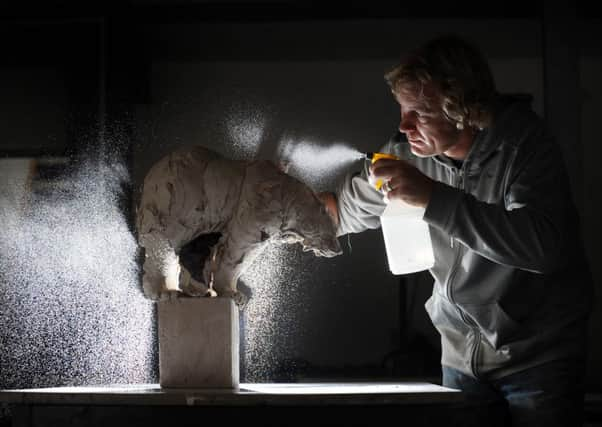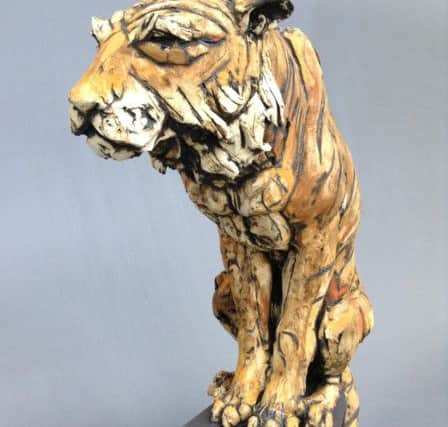Beauty of the beast: Conjuring mammals from memory


“A lot of people think I work from photographs, I don’t at all,” Hesmondhalgh says over coffee in the warehouse turned group studios he shares with 11 other artists. “If I do a new subject I go and look, I might read about that animal. The large bear at Chelsea [Flower Show] this year is one of them. I got obsessed with reading stories about bears chasing people in America. I don’t know why I was reading about them, it’s like the whole Jaws thing getting scared of sharks, but it’s an idea of what this animal is like I suppose.
“Then I make it from memory. I might look at some images and then put them all to the side and make my version. What happens then becomes a lot more spontaneous, there’s a lot more life in the piece.”
Advertisement
Hide AdAdvertisement
Hide AdHe’s right. The animals are clearly made from clay – he intends to preserve what he calls the “clayness” of the medium – often with splashes of colour or unnatural circles to suggest a muscle, a mood.


Perhaps he draws a plan beforehand?
“Do you know what, I have this desire to draw and paint because I keep buying expensive rolls of paper and paintbrushes and pencils and I’ve got loads of them; it’s like an art shop at my studio at home and I don’t use any of them. I want to but I think there’s a fear there of drawing on paper, I haven’t quite broken it. These really are my drawings, I feel very free in that material and I feel comfortable with it.”
It’s hard to imagine the 43-year-old sculptor in any other profession but, as an 18-year-old college student working part-time in the family building business in Lancashire, the idea of becoming an artist never occurred to him. His intention was to study criminology at university – he studied the “bizarre mixture” of law, sociology and ceramics at A-Level – but he admits to spending “more time in the ceramics room than I did in the law classroom”.
He says: “It was only down to my law teacher and my art teacher at the time. They pulled me into a meeting just before we applied for our options at university and my law teacher said: ‘I don’t think you’ll enjoy it’. So I was thinking: ‘What am I going to do?’ and my art teacher said: ‘We’ve got you a place here’. They’d actually applied to art college in north Wales without asking me. I didn’t know what art college was, I had no idea there was an option. It was terrifying.


Advertisement
Hide AdAdvertisement
Hide Ad“I got there and it was full of a lot of strange-looking people a lot cooler than me, creative-looking, dare I say, so I was out of my comfort zone. But I went really to improve. I loved making so that’s what I went to do and my father’s parting words were ‘don’t ring me for any money’. Literally, I put my suitcase on the road and he turned and drove back to Lancashire and that always stuck with me because I realised at that point that if I was going to make it work I had to get to sell work.”
After two years honing his ceramic skills among those creative-looking students in north Wales, Hesmondhalgh invited his father to his end of year show.
“My dad – it’s a very working class family he’s never been in an art gallery in his life – he turned up in a suit looking like he was going to a wedding. He came into the gallery and I could tell he was really nervous. He went round and said: ‘What do all the red stickers mean?’ and I said: ‘It means they’re sold’. He completely changed his mind from that point because he knew I could make a living from it… I never rang him for money, I felt quite pleased about that.”
Two more years of focused study in Edinburgh later and Hesmondhalgh was awarded a grant from the Arts Council. At 23, his first exhibition on the King’s Road in London was a sell-out which would inform the next 20 years of shows.
Advertisement
Hide AdAdvertisement
Hide AdHe laughs when I raise the idea of spare time but any he does get is spent with wife Rebecca and children Matilda, 12 and Emmanuel, 11.
He says: “The romantic idea of an artist’s life being wandering round fields and doing little sketches isn’t true, I don’t believe that’s true for many artists at all. It’s chaotically beautiful and beautifully chaotic.”
Of course, many artists don’t also run a creative business; Hesmondhalgh has rented out studio space and run workshops for the last seven years and has recently bought a huge mill in countryside near Holmfirth to expand the offering.
Later this month he will join more than 100 other artists at the Art Market, an event he co-founded nine years ago with his sister-in-law Victoria Robinson and ceramicist Emily Stubbs. From small beginnings in Holmfirth, the Art Market will this year take over York Racecourse for three days of workshops, demonstrations and exhibitions.
Advertisement
Hide AdAdvertisement
Hide AdHaving had early support himself, Hesmondhalgh is particularly proud to offer 12 upcoming artists places on the RAW Graduate Scheme which includes free space at the Art Market, expenses, accommodation and mentoring.
He says the opportunity for artists starting out to sell is so important.
“I say to a lot of young artists here, it’s not just about selling for the commercial aspects or that you need to live or pay a mortgage. The fact someone comes along and wants to pay X amount for your drawing or your painting or your sculpture makes you feel like you’re doing something right. You think: ‘Wow, actually somebody else likes what I do’, so you go back in on Monday morning and you carry on. Some artists might tell you they’re not interested in selling their work and they don’t want to be commercial at all. I don’t really believe them; it’s not just about money, it’s about being acknowledged.”
Hesmondhalgh would take repeat orders for his early dog sculptures. “There was one gallery in Knightsbridge that would ring me up and say: ‘Right, I want a Boston terrier, a bulldog’. I sold sculptures to half the Chelsea football team, Emmanuel Petit bought a French bulldog naturally, and you’re thinking ‘do I want to make dog sculptures for celebrities to look like the real thing?’ and the answer was no. I felt like a machine. I got paid well for it but I got to the point where I thought: ‘I don’t want to do this, I feel like I’ve become a pet portrait artist and that makes me a cringe a little bit’. It’s just not what I want to do. I want people to want to buy a piece of my sculpture because they like my work not because they want a version of their animal.”
Advertisement
Hide AdAdvertisement
Hide AdDespite his success he admits that he doesn’t have any of his own sculptures in his house. “Eventually I’ll probably keep something I’m really happy with but I’ve not found it yet.” And he frequently smashes up those that don’t meet his high standards, much to the dismay of gallery owners who would have happily sold them.
His next step after the Art Market is an 18- month residency at a company that makes industrial clay pipes. He is looking forward to concentrating his usually hectic schedule on a body of work that he hopes will be his legacy.
“I’m slightly nervous about what I’m going to produce and what other people will think of it… I don’t know, I haven’t worked out who I’m trying to impress yet, underlying it’s probably me.”
Having taken up a good part of the morning chatting, I realise it’s probably time I dragged myself away from the sculptor’s appealing menagerie.
Advertisement
Hide AdAdvertisement
Hide AdHesmondhalgh says: “I’ve learned a bit more about myself talking to you, you know.”
Is it like therapy? “It is a little bit like therapy, I should be paying you! When you allow yourself to think about it and talk about it you do start to consider what you’re doing and why you’re doing it.”
• The Art Market is at York Racecourse from September 30 to October 2. For tickets and information visit http://artmarkets.co.uk/york